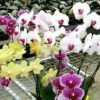# Exploring the Development of Dendrobium in the Commercial Orchid Industry

The Dendrobium orchid, one of the largest and most diverse genera in the Orchidaceae family, holds a significant position in the commercial orchid industry. Its vibrant colors, unique shapes, and versatile growth habits make it a favorite among both hobbyists and commercial growers. This article will delve into the development of Dendrobium orchids in the commercial sector, exploring their cultivation, market trends, challenges, and future prospects.
## 1. Introduction to Dendrobium Orchids
### 1.1 Overview of the Dendrobium Genus
Dendrobium orchids comprise over 1,800 species, primarily found in Southeast Asia and the Pacific Islands. Known for their striking flowers and varied growth habits, Dendrobiums are popular among orchid enthusiasts. Their ability to thrive in diverse environments, from lowland rainforests to mountainous regions, contributes to their adaptability and resilience.
### 1.2 Characteristics of Dendrobium Orchids
Dendrobiums exhibit a wide range of characteristics that make them appealing for commercial cultivation:
– **Diverse Flower Forms**: Dendrobium flowers come in various shapes, sizes, and colors, including white, yellow, pink, purple, and blue. This diversity allows growers to cater to different consumer preferences.
– **Long Flowering Period**: Many Dendrobium species and hybrids have extended blooming periods, making them attractive for floral arrangements and as ornamental plants.
– **Adaptability**: Dendrobiums can be cultivated in various settings, including greenhouses, outdoor gardens, and as potted houseplants, making them versatile for different markets.
## 2. Historical Context of Dendrobium in Commercial Horticulture
### 2.1 Early Cultivation and Trade
The history of Dendrobium orchids in commerce can be traced back to the late 19th century when European collectors began importing exotic plants from Southeast Asia. The unique beauty of Dendrobiums quickly captured the attention of orchid enthusiasts and commercial growers alike. As interest in orchids grew, so did the demand for Dendrobium species, leading to increased cultivation and trade.
### 2.2 Development of Hybrid Varieties
The 20th century saw significant advancements in orchid breeding techniques, leading to the creation of numerous hybrid varieties of Dendrobium. These hybrids often exhibited improved traits, such as increased flower size, enhanced colors, and greater resistance to pests and diseases. The introduction of hybrid Dendrobiums revolutionized the commercial orchid market, providing growers with new opportunities for profit.
### 2.3 Global Trade and Market Expansion
As the global orchid market expanded, Dendrobium orchids became increasingly popular due to their adaptability and wide appeal. Countries like Thailand, Taiwan, and the Philippines emerged as major exporters of Dendrobium orchids, establishing themselves as key players in the global horticultural trade. The growth of international trade networks facilitated the distribution of Dendrobium orchids to various markets, including North America, Europe, and Asia.
## 3. Cultivation Practices for Dendrobium Orchids
### 3.1 Growing Conditions
Successful cultivation of Dendrobium orchids requires specific environmental conditions:
– **Light**: Dendrobiums thrive in bright, indirect light. Growers often use shade cloth or filters to prevent direct sunlight from burning the leaves.
– **Temperature**: Dendrobiums prefer temperatures ranging from 65°F to 85°F (18°C to 29°C). Maintaining consistent temperature levels is essential for healthy growth and blooming.
– **Humidity**: A humidity level of 40% to 60% is ideal for Dendrobium orchids. Misting plants or using humidifiers can help maintain appropriate humidity levels.
### 3.2 Potting and Medium
Choosing the right potting medium is crucial for the success of Dendrobium orchids. Common potting mixes include:
– **Bark Mixes**: A mixture of pine bark, perlite, and charcoal provides excellent drainage and aeration, essential for the health of the roots.
– **Sphagnum Moss**: Often used for young plants or those requiring additional moisture retention, sphagnum moss helps maintain humidity around the roots.
### 3.3 Watering Practices
Watering is a critical aspect of Dendrobium care:
– **Watering Frequency**: Growers should water Dendrobium orchids thoroughly, allowing the potting medium to dry slightly between waterings. Overwatering can lead to root rot, while underwatering can cause stress and yellowing leaves.
– **Fertilization**: Regular fertilization with a balanced orchid fertilizer is essential for healthy growth. Many growers use a weak liquid fertilizer every two to four weeks during the growing season.
### 3.4 Pest and Disease Management
Pest and disease management is vital for maintaining healthy Dendrobium orchids. Common pests include aphids, mealybugs, and spider mites. Growers should regularly inspect plants for signs of infestation and treat affected areas promptly using insecticidal soap or neem oil.
## 4. Market Trends and Demand for Dendrobium Orchids
### 4.1 Increasing Popularity
The popularity of Dendrobium orchids has surged in recent years due to their aesthetic appeal and versatility. As consumers seek unique and exotic plants for their homes and gardens, Dendrobiums have become a preferred choice. This increasing demand has prompted growers to expand their cultivation efforts and diversify their offerings.
### 4.2 Specialty Markets
Dendrobium orchids are finding their place in specialty markets, including:
– **Wedding and Event Floristry**: The vibrant colors and elegant forms of Dendrobium flowers make them popular choices for floral arrangements in weddings and special events.
– **Interior Design**: The rise of indoor gardening and houseplants has led to an increased interest in Dendrobium orchids as decorative houseplants.
– **Gifts and Souvenirs**: Dendrobiums are often used as gifts, particularly in Asian cultures where orchids symbolize love, beauty, and luxury.
### 4.3 Online Sales and E-Commerce
The growth of e-commerce has transformed the orchid market, providing growers with new opportunities to reach consumers directly. Online platforms allow customers to purchase Dendrobium orchids from the comfort of their homes, increasing accessibility and convenience. As a result, many growers are investing in online marketing and sales strategies to capitalize on this trend.
## 5. Challenges in the Dendrobium Commercial Industry
### 5.1 Competition
The commercial orchid market is highly competitive, with numerous growers vying for market share. This competition can drive down prices and make it challenging for smaller growers to remain profitable. As a result, many growers are focusing on niche markets or unique varieties to differentiate themselves from competitors.
### 5.2 Pest and Disease Pressure
Pests and diseases pose ongoing challenges for Dendrobium growers. Outbreaks of pests such as aphids and thrips can quickly devastate crops, leading to significant financial losses. Similarly, diseases such as root rot and fungal infections can threaten plant health and yield.
### 5.3 Environmental Concerns
As with many agricultural industries, environmental concerns are becoming increasingly important in the Dendrobium commercial sector. Issues such as water usage, pesticide application, and sustainable farming practices are being scrutinized by consumers and regulators alike. Growers are urged to adopt environmentally friendly practices to ensure the sustainability of their operations.
### 5.4 Climate Change Impacts
Climate change poses a significant threat to the Dendrobium orchid industry. Altered weather patterns, increased temperatures, and extreme weather events can impact the growth and survival of Dendrobium orchids. Growers must adapt their cultivation practices to mitigate these effects and ensure the long-term viability of their crops.
## 6. Future Prospects for Dendrobium Orchids
### 6.1 Advancements in Technology
Technological advancements are expected to play a vital role in the future of Dendrobium cultivation. Innovations in growing techniques, such as hydroponics and automated climate control systems, can enhance efficiency and yield. Additionally, advancements in breeding technology may lead to the development of new and unique Dendrobium hybrids with desirable traits.
### 6.2 Sustainability Initiatives
Sustainability is becoming a priority for many growers as consumers increasingly demand environmentally friendly products. The adoption of sustainable practices, such as organic growing methods, water conservation, and responsible pesticide use, will be essential for the future of the Dendrobium orchid industry.
### 6.3 Expanding Market Opportunities
As consumer interest in unique and exotic plants continues to grow, the market opportunities for Dendrobium orchids are likely to expand. Growers can capitalize on this trend by introducing new varieties, enhancing their marketing efforts, and exploring niche markets.
## Conclusion
The development of Dendrobium orchids in the commercial industry has been a fascinating journey marked by innovation, adaptation, and resilience. As the market for orchids continues to grow, Dendrobium orchids remain at the forefront due to their beauty, versatility, and widespread appeal. By understanding the cultivation practices, market trends, challenges, and future prospects, growers can navigate the commercial orchid industry effectively and continue to contribute to the ongoing popularity of Dendrobium orchids worldwide. The future looks bright for Dendrobium orchids, with ample opportunities for growth and success in the ever-evolving horticultural landscape.

